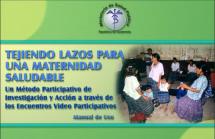Tying Knots for Healthy Motherhood
The purpose of this practical guide and participant’s manual is to lead a facilitator or trainer and the participants, step by step, through the application of a methodology of participatory research in a health project.
The phrase “tying knots” is used to refer to a “tapestry of knots” which is an indigenous Guatemalan phrase used to reflect the components and characteristics of the participatory research process that includes this particular method of investigation. The knots represent at once permanence and change, since every tradition has a past (has history), and at the same time has a future and evolves with time. The knots are, therefore, not only outputs but also processes since they are continually created and recreated over time. Moreover, the knots symbolize community, mutual support, the formation of networks, and solidarity.
The subjects of the videos presented in this guide are related to maternal and neonatal health, but the end result is to provide a tool that can support someone in resolving any health problem, and which can be adapted to the needs of the community and of organizations desiring to carry out participatory research (or participatory investigation). The term “participatory video discussion meeting” is used to describe a meeting in which videotaped images (short films) from a real situation are used to stimulate dialogue and discussion among the participants. The facilitator’s guide consists of three parts and a section of appendices at the end. The participant’s manual consists of seven steps, from introductions of the participants to gaining an understanding of the situation and developing solutions.
Source: Johns Hopkins University Center for Communication Programs, JHPIEGO
Date of Publication: March 25, 2019
SIMILIAR RESOURCES
Tools
Examples
- Infant and Young Child Feeding Recommendations When COVID-19 is Suspected or Confirmed
- SBCC for Malaria in Pregnancy: Strategy Development Guidance
- Talking to Children about Illness and Death of a Loved One during the COVID-19 Pandemic
- COVID-19 in Pregnancy and Lactation
- The REPLACE Approach: Supporting Communities to End FGM
- Improving the Health of Women, Children and Adolescents - from Evidence to Action: Online Course
- Guidance on Developing a National Deployment and Vaccination Plan for COVID-19 Vaccines
- ORB
- COVID-19, Maternal and Child Health, and Nutrition
- Promoting the Health of Men who Have Sex with Men Worldwide: A Training Curriculum for Providers

